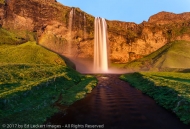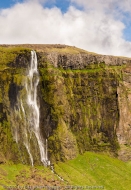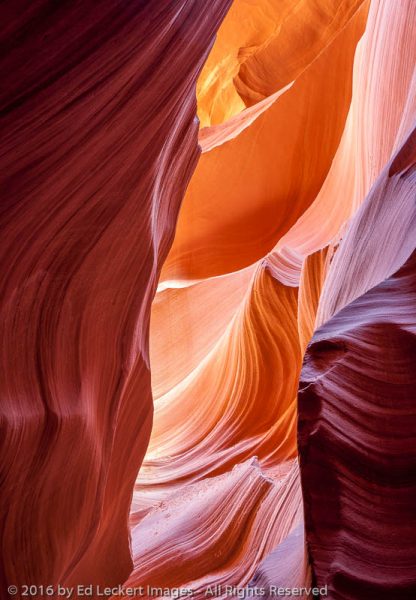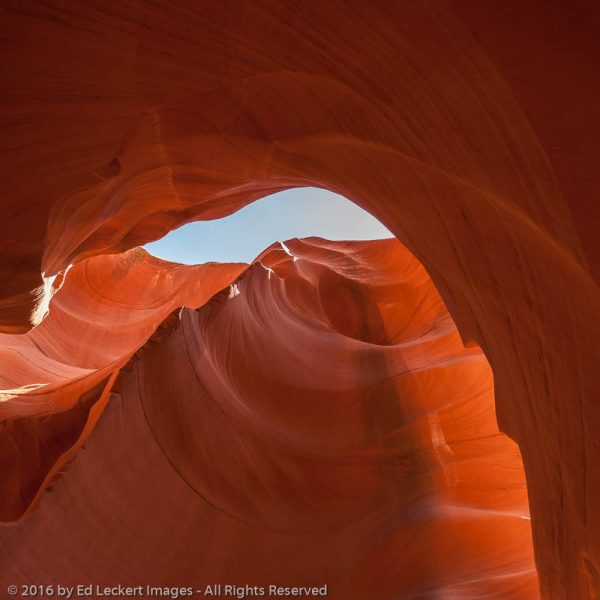


What do you do after you’ve finished photographing Monument Valley, from the famous Milepost 13 image to the equally famous Mittens images? Well, you keep shooting, because there seems to be no end to the iconic scenery available for the landscape photographer to find in the Southwest!
In a recent article, Something About Mittens, my friend Jeremy and I had been camping directly in front of one of the Southwest’s greatest icons, The Mittens, where we had been treated to a beautiful sunrise. But the day was just beginning! This afternoon we had reservations for a Photographers’ Tour of Lower Antelope Canyon, an amazing slot canyon near Page, Arizona.
Back in 2012, we had toured the area and had taken the Photographers’ Tour of Upper Antelope Canyon. Both lower and upper canyons are on Navajo property and require that a Navajo guide accompany anyone entering the area. Fortunately, the guides do a very good job of managing the million or more people who flock to the area each year to see these amazing natural wonders. And if you pay extra for the Photographers’ Tour, you get priority when things get really crazy, and you get to stay about twice as long as the standard tour participants. So of course we always do the longer tour, because even that one seems to end almost before it starts.

Sandstone scoured by countless flash floods glows in the late afternoon sun, in the slot canyons of Lower Antelope Canyon, Page, Arizona.
The weather forecast had been questionable, but when the time came to go on the tour, the sun was out and there was no danger of flash floods. I cannot emphasize enough the importance of staying informed when going into a slot canyon. Those scour marks on the walls didn’t get there by accident – they are a constant reminder of the powerful forces that carved these canyons in the first place. It doesn’t even have to be raining in the immediate area for trouble to brew. Flash floods can be caused by storms up to a hundred miles away in some terrain, and when water and debris come barreling down the canyon, you have little or no time to escape.
From a photographer’s perspective, a sunny day is vital. Slot canyons are one of the rare instances where direct overhead sunlight is the preferred lighting. In fact, I can’t think of another case where this lighting is acceptable, but then I didn’t think very hard.
The reason this lighting works is that sandstone walls reflect mostly orange/red colors. If you have a situation where multiple sandstone walls are in close proximity such that the sunlight bounces back and forth from one wall to another, over and over again, the light becomes deeper in color or more saturated with each bounce, and nowhere is this more apparent than in a slot canyon lit from overhead. And if you can get the sunlight to come straight down a narrow slit, you get the added bonus of a spotlight on the canyon floor. That wouldn’t happen on this tour, as we were shooting in late afternoon, but it did happen on our last tour in 2012.
One thing to keep in mind if you shoot with an SLR and have multiple lenses is that you never want to change lenses in this environment, with sand on the floor, sand pouring into the canyon from above, and lots of people running around stirring up sand. If you try to change lenses, you are guaranteed to get lots of sand inside your camera, and that’s not good. As it is, expect to have to clean off all exposed surfaces of the camera and lens.

A gap above the walls allows the sky to peek through to the slot canyon floor, in Lower Antelope Canyon, Page, Arizona.
The time for our tour arrived and our guide led us down a series of ladders and into the canyon. As soon as you enter, the shapes and colors of the canyon walls entice you to start shooting. Of course we had the conflicting goals of trying to stay together as a group as well as spreading out to stay out of each others’ shots, but we managed to work it out in the end. It was a bit stressful, trying to keep others out of your shots, stay out of their shots, and get what you wanted in the limited amount of time, but I’m happy with the results.
In what seemed like no time at all, the time was up and we exited the slot. As always, while I thought I had some good images, I never really know until I see them on a large monitor. That would have to wait until I returned home a week or so later!

Great pictures Ed! Do you sometimes get a person in a shot to give some perspective of the size of some of the features you are shooting? Speaking of dirt and cameras, do you know a good place locally where I can get my SLR cleaned? I think I have something stuck to my CCD.
Max
Thanks, Max! I generally don’t include people, but if I were shooting stock I would. I clean my own sensors, but the two major stores in town are Glazer’s and Kenmore. If they don’t do it, they’ll know who does. I suspect they’ll just send it to the manufacturer.
Could I clean the CCD myself with a lens brush if I can get the shutter to stay open or is that not advised?
Not a good idea at all. Never touch your sensor with anything unless you are fully aware of the process. The only thing you might try is the Rocket Air Blaster, but you still have to know what you’re doing as far not touching the tip to the sensor, having a fully charged battery, pointing the open end down, never using a cheap blower because they spray rubber particles, and never ever use canned air. Etc., etc., etc. Disclaimer on file. 🙂
Thanks for your advice Ed.
We also had great luck last year at the ‘Secret Canyon’ – on privately owned land, not too far from Antelope. A bit pricier, but there was only one other visitor besides Pat and myself. Same great views, just less hassle
I might have to try that next time, Bill.